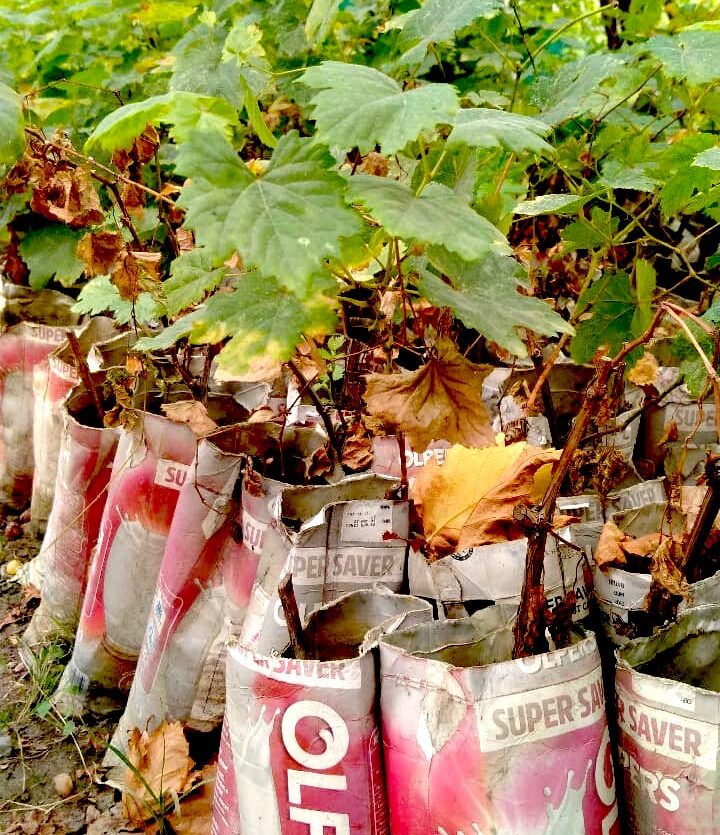By Fazila Abbas
In the heart of the Gilgit mountains, a place of unparalleled natural beauty, I have always felt deeply connected to the environment. As an environmentalist, my passion for plants and sustainable living led me to embark on a unique journey that combines urban land use and ecological restoration.Today I want to share with you my story of transforming an unused rooftop into a thriving green space and how this initiative contributes to land restoration.

The Birth of a Green Roof
Living in a mountainous area, the terrain around my house is often hilly, making traditional gardening difficult. But the roof that large, flat, unused space has potential.With determination and love for nature, I prepared more than 200 boxes and planted grape vines in them.
Today, I have over 200 vines growing on our roof.This green awning not only enhances the aesthetics of my home, but is also a testament to what can be achieved with just a little creativity and effort.
Turning waste into wealth
Reusing milk cartons, in my quest for sustainability, I have also turned to reusing everyday waste. Milk cartons , often thrown away without a second thought, have become the perfect containers for growing plants. By reusing these boxes, I not only reduce waste but also create the right environment for young plants to grow. This activity emphasizes the principle of reusing materials for the benefit of the environment, fully consistent with the goal of land restoration.
Delopment Goals (SDGs), this project contributes to :
- SDG 11 – Sustainable cities and communities by making urban areas resilient and more sustainable
- SDG 12 – Responsible consumption and production by promoting the reuse of materials
- SDG 13 – Climate action by minimizing the impact of climate change through improving air quality and reducing urban heat islands, and;
- SDG 15 – Life on land by enhancing biodiversity and improving soil health to support sustainable use of ecosystems on land

Aligning Rooftop Gardening with the SDGs
The rooftop grapevine initiative in Gilgit illustrates how to transform urban spaces into paradise green, bringing many benefits to the environment.
This project significantly improves air quality as grape vines absorb carbon dioxide and release oxygen, while their leaves act as natural air filters, trapping dust and pollutants. Extending this practice to in-ground gardens will improve soil quality, as grape vine roots help prevent soil erosion, improve soil structure, and increase organic matter content.
In addition, green roofs provide habitat for many different species of insects and birds, promoting local biodiversity and nurturing a thriving micro-ecosystem.
Growing your own grapes reduces dependence on commercially grown produce, which often involves toxic pesticides and long transportation routes, supporting sustainable agricultural practices.
The project also engaged the community, inspiring neighbors and friends to embark on their own green initiatives, creating a collective effort to restore the land.
Aligned with several United Nations Sustainable Development Goals (SDGs), this project contributes to :
- SDG 11 – Sustainable cities and communities by making urban areas resilient and more sustainable
- SDG 12 – Responsible consumption and production by promoting the reuse of materials
- SDG 13 – Climate action by minimizing the impact of climate change through improving air quality and reducing urban heat islands, and;
- SDG 15 – Life on land by enhancing biodiversity and improving soil health to support sustainable use of ecosystems on land
The Broader Impact of Land Restoration
Land restoration is an important topic in the fight against environmental degradation and climate change. By restoring degraded land, we can improve food security, fight climate change and preserve biodiversity.
My rooftop vineyard project, although small in scale, contributes to these larger goals by demonstrating how urban space can be reused for ecological benefit.In Gilgit, where land is often limited by mountainous terrain, such initiatives can have a significant impact on local communities.
They offer practical solutions to improve environmental health and offer a model that can be replicated in other urban areas with limited green space.

Final Word
My journey with rooftop vines has been deeply enriching, both personally and environmentally. This is a small step towards land restoration but it shows the power of innovative thinking and sustainable practices.
By taking advantage of underutilized urban spaces, we can contribute to a healthier planet and inspire others to get involved. Let us continue to explore and implement such initiatives, thereby promoting a greener and more sustainable future for all.
In the spirit of land restoration and sustainable living, I encourage everyone to look at their surroundings and find ways to make a positive impact.
Whether it’s a rooftop garden, a community green space, or a simple practice of reusing materials, every effort counts. Together, we can restore the land and create a thriving environment for future generations.
This blog is published as part of the Abadtak x Climate Action PK Scicomm Challenge and the Abadtak Mentorship Programme.
Interested to Start your Own Rooftop Garden?
Download our FREE kitchen gardening guide for schools
Download Now


